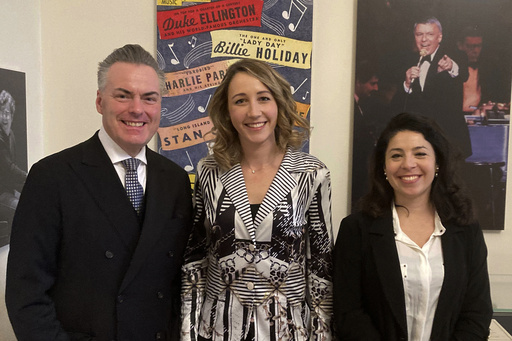NEW YORK (AP) — Andrea Götsch was surprised when she won her audition in 2019 that led to membership in the Vienna Philharmonic.
“When I went home, I was just laughing because I couldn’t realize that they had really taken me,” the 29-year-old clarinetist told The Associated Press. “It was always kind of a dream. As a young child already, I watched the New Year’s concert, but it was never a goal. I thought that was too far away.”
A male bastion from its founding in 1842 until 1997, the Vienna Philharmonic now has 24 female players among 145 members with three vacancies as it tours the United States this week.
“It’s very positive to me. It’s a completely normal way of us living with each other. And we all have one main goal, to give the best possible concert — and that unifies us,” said Daniel Froschauer, chairman of the self-governing ensemble. “Look at music schools: There are many more women than men. And we want the best members, so it was the right decision.”
Based since 1870 at Vienna’s Musikverein, the Vienna Philharmonic elects leadership, engages conductors, chooses programs and schedules tours and recording sessions. It selects members from the Vienna State Opera Orchestra and has had a summer residency at the Salzburg Festival since 1922.
Harpist Anna Lelkes played with the Philharmonic for 26 years as a nonmember before she became the first woman admitted. Albena Danailova became an acting concertmaster in 2008 and was granted membership in 2010. The 48-year-old had the high-profile position leading the strings in Sunday’s performance of Mahler’s Ninth Symphony with conductor Franz Welser-Möst at Carnegie Hall.
VPO women include 14 violins, two violas, two cellos, one double bass, two harps, one flute, one clarinet and one bassoon.
The Berlin Philharmonic, widely considered Europe’s other great orchestra, admitted Swiss violinist Madeleine Carruzzo as its first female in 1982 and currently has 26 women, 99 men and five vacancies.
The New York Philharmonic’s first female musician was harpist Stephanie “Steffy” Goldner in 1922 and it now has 49 men and 45 women with 12 vacancies. The Chicago Symphony Orchestra made principal horn Helen Kotas its first rostered female in 1941 and started this season with 59 men, 34 women and 15 openings.
Froschauer, a first violinist who has been a VPO member since 1998, was elected chairman in 2017. He said about 100 people apply for each open position in the State Opera Orchestra and a quarter are given auditions behind screens for a jury of roughly two dozen. They play pieces chosen by the jury head and are graded, with 20 points the most. Those with 11 points or more advance, and after the second round the field is cut to five, then culled further for the final round.
“A jury member has to say, ‘I’d like to ask to remove the screen,’” Froschauer said. “All the points are cumulative and usually there is one person who has a certain amount. There’s no more screen and sometimes there’s three ladies and sometimes there’s three guys. Sometimes it’s a mix. But the most important thing is what are the points?”
Winners get a one-to-two year trial with the State Opera Orchestra, and then a person will be considered for admission. After two more years, they can apply for membership to the Philharmonic.
Harpist Anneleen Lenaerts, 36, applied for an opening at the suggestion of a friend, Xavier de Maistre, who left the Philharmonic for a solo cello career. She took a flight from Brussels just before Christmas for a pre-audition and then the main audition the next day in the Mahler Hall of the State Opera. She was among two finalists who waited in an adjacent room while the jury deliberated, and they were both called in for the announcement by Michael Bladerer, the double bass who chaired the jury and is now the orchestra’s general manager, its No. 2 official.
She debuted at State Opera in Strauss’ “Arabella” with Welser-Möst in 2011 and was admitted to the Philharmonic in 2014, just its eighth woman.
“I was a freelancer, playing solo and chamber music, which I loved. And I never expected to end up in an orchestra like this,” Lenaerts said. “It is a different country with a different history, different mentality, different language. All of that was new for me. (…) You just have to prepare as best as you can and then hope that in the pit it will go well. And on top of that, you have the schedule of the Vienna Philharmonic.”
Götsch, the clarinetist from Bolzano, Italy, was called into the orchestra as a substitute at the suggestion of VPO member Johann Hindler. She began at the opera with Verdi’s “La Traviata” in 2016 and played with VPO for the first time a year later in Mahler’s Sixth Symphony with Daniel Harding. She won her audition in 2019.
A year later, she was confirmed for the Opera Orchestra and in 2022 she became a VPO member. Götsch sits on the orchestra’s management committee with the title Ordnungswahrerin (Order Keeper), where she keeps track of attendance at rehearsals and performances and deals with quick personnel changes.
“Sometimes they get sick an hour before the concert and so they call me and say ‘I cannot play. Can you help?'” she said. “I have to make sure that there are enough people.”
Source: post





